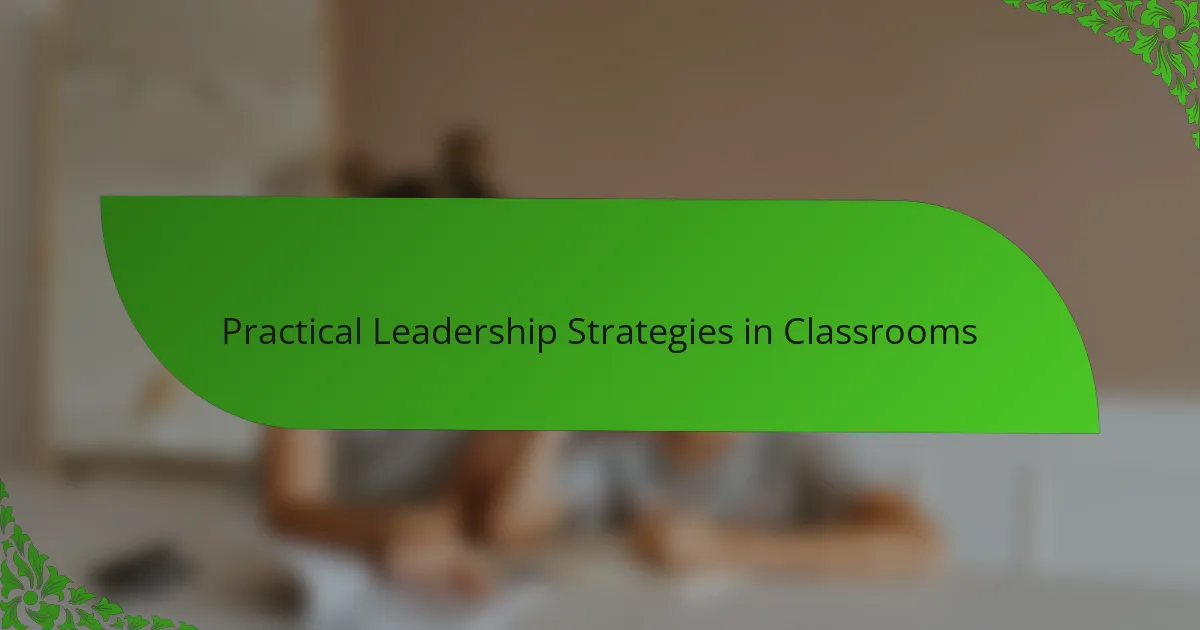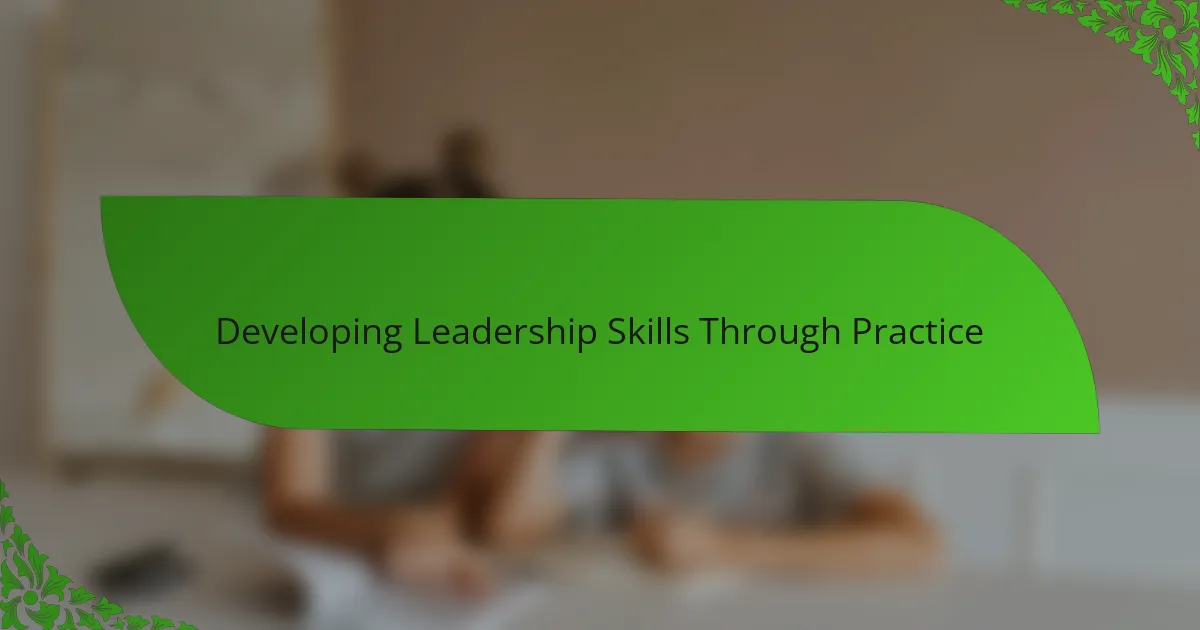Key takeaways
- Leadership styles are unique and shaped by personal experiences, emphasizing the importance of authenticity and empathy.
- Sheryl Sandberg’s principles highlight vulnerability as a strength, encouraging leaders to create trust and open communication.
- Empathy and genuine connection are fundamental for effective leadership, fostering an environment for growth and motivation.
- Developing leadership skills requires hands-on practice and embracing challenges, contributing to resilience and adaptability.

Understanding Leadership Styles
Leadership styles are more than just labels; they are reflections of how we connect with others and inspire action. I’ve often wondered: what makes one leader’s approach resonate deeply while another’s falls flat? In my experience, understanding these differences is the key to meaningful leadership.
When I reflect on various leadership styles, I see them as unique fingerprints—each shaped by values, experiences, and sometimes, vulnerability. Sheryl Sandberg’s insights remind me that effective leadership is not about fitting into a mold but about embracing authenticity and empathy. Have you ever noticed how some leaders make you feel seen and empowered? That’s no coincidence.
What strikes me most is how leadership styles evolve through self-awareness and reflection. It’s not static or one-size-fits-all; it’s a dynamic dance that requires constant adaptation. I find it inspiring to view leadership as a personal journey, one that challenges us to grow alongside those we lead.

Key Leadership Principles by Sheryl Sandberg
Sheryl Sandberg’s leadership principles really resonate with me because they emphasize vulnerability as a strength, not a weakness. She teaches that admitting when we don’t have all the answers creates trust and openness—something I’ve seen transform team dynamics firsthand. Doesn’t it feel more human and powerful when a leader shows they’re not perfect?
Another principle that stands out is her focus on leaning in, which goes beyond just ambition; it’s about leaning into challenges and opportunities with confidence. I remember facing a tough decision at work and recalling Sandberg’s advice gave me the push to speak up and own my ideas. Have you ever held back simply because you doubted your voice mattered?
Finally, Sandberg champions the importance of empathy and support in leadership. She believes inspiring others isn’t about authority but about connection. When I started leading my own team, applying this principle helped me create an environment where people felt safe to grow and innovate. Isn’t that the kind of leadership we all want to follow?

Philosophical Foundations of Leadership
Philosophically, leadership taps into timeless questions about human nature and ethics. I often ponder how leaders balance the desire to guide with the respect for individual freedom—a tension that reflects the core debates in philosophical thought. Have you ever thought about how a leader’s moral compass shapes not just decisions but the very culture they cultivate?
The concept of leadership also draws heavily from existential ideas about authenticity and responsibility. When I consider Sandberg’s emphasis on vulnerability, it reminds me of the philosopher Søren Kierkegaard’s notion that true selfhood requires embracing our imperfections. Doesn’t it make sense that embracing who we are, flaws included, creates a stronger foundation for leading others?
From a practical standpoint, I see leadership philosophies as frameworks that help us navigate complexity. The ancient virtue ethics teach us that character—things like courage and empathy—form the backbone of effective leadership. This makes me ask: are we focusing enough on developing these virtues within ourselves to truly inspire those around us?

Applying Sandberg’s Insights to Education
Applying Sandberg’s emphasis on vulnerability in education means creating classrooms where students feel safe to express uncertainty. I recall a time when I encouraged a student to admit they didn’t understand a concept—what felt like a small moment actually sparked deeper engagement and trust. Couldn’t this approach shift how we view mistakes—not as failures but as essential parts of learning?
Her idea of “leaning in” also translates powerfully to educators embracing challenges head-on, whether it’s adopting new teaching methods or addressing difficult conversations. I’ve found that when teachers model this confidence, students often mirror it, stepping up in ways I hadn’t anticipated. How might our classrooms transform if every teacher leaned in with the same boldness Sandberg advocates?
Finally, Sandberg’s focus on empathy calls on educators to connect authentically with students, recognizing their unique backgrounds and struggles. From my experience, empathy isn’t just a nice-to-have; it’s the foundation for inspiring motivation and resilience. When have you seen empathy change the trajectory of a learner’s journey?

Practical Leadership Strategies in Classrooms
In classrooms, practical leadership strategies often start with creating a space where vulnerability is welcomed. I’ve noticed that when students feel safe enough to admit confusion or share uncertainties, learning becomes more meaningful and collaborative. Doesn’t that sense of trust transform the entire classroom dynamic?
Another strategy I find effective is encouraging both teachers and students to “lean in” to challenges, much like Sandberg suggests. I remember a teacher colleague who embraced a new technology despite initial doubts—her confidence sparked enthusiasm among students who then challenged themselves in surprising ways. How often do we give ourselves permission to step boldly into the unknown with our students?
Empathy, in my experience, completes this trio of strategies by fostering genuine connections. Recognizing each student’s unique story and struggles helps tailor support that feels personal and empowering rather than generic. When have you witnessed a simple act of understanding shift a student’s motivation profoundly?

Reflecting on Personal Leadership Experience
Looking back on my own leadership journey, I realize how much growth came from moments of doubt and uncertainty. There was a time when I hesitated to speak up in a team meeting, fearing my ideas weren’t valuable enough. Reflecting now, I see how leaning into that discomfort—just as Sheryl Sandberg suggests—helped me find my voice and gain confidence.
Leadership, for me, has often meant navigating the delicate balance between directing others and being open to their perspectives. I’ve learned that admitting I don’t have all the answers creates a space where collaboration flourishes. Have you ever noticed how vulnerability can actually strengthen your authority rather than weaken it?
Sometimes, my personal leadership experiences feel like ongoing experiments in empathy and authenticity. I remember a challenging project where I focused less on control and more on truly listening to my team’s concerns. The shift was subtle but powerful—people became more engaged, and outcomes improved. Isn’t it fascinating how leadership changes when you prioritize connection over command?

Developing Leadership Skills Through Practice
Developing leadership skills is something I’ve come to appreciate as a hands-on process rather than a checklist to complete. When I first tried to lead a small project, I quickly realized that theory only gets you so far—real growth happens when you’re faced with unexpected challenges that test your patience and adaptability. Have you ever noticed how those moments of trial force you to rethink your approach and develop new skills on the fly?
Practice also teaches you the subtle art of balancing confidence with humility, something Sheryl Sandberg emphasizes through vulnerability. I found that by regularly stepping into leadership roles, even in low-stakes environments, I became more comfortable admitting mistakes and asking for help. This openness didn’t diminish my authority; it actually made others more willing to follow and collaborate. Isn’t that a powerful paradox worth embracing?
What strikes me most is how consistent practice builds not just skills but resilience. Each attempt, whether successful or not, adds a layer of insight and self-awareness. I often ask myself: how can I create more opportunities to lead in small, everyday ways? Because it’s in those moments that leadership truly comes alive—through experience, reflection, and the courage to keep trying.